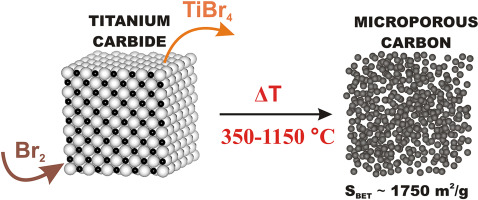Microporous and Mesoporous Materials ( IF 4.8 ) Pub Date : 2018-06-23 , DOI: 10.1016/j.micromeso.2018.06.037 Sławomir Dyjak , Wojciech Kiciński , Małgorzata Norek , Michał Dyjak , Stanisław Cudziło

|
Carbide-derived carbons (CDCs) are synthesized from TiC micropowder via gas phase bromination at the temperature range of 350–1150 °C. The resultant carbon materials demonstrate high specific surface areas and micropore volumes of up to 1745 m2 g−1 and 0.64 cm3 g−1 respectively. Successful bromination of TiC in a wide temperature range permitted the first in-depth comparative study of CDCs produced by Br2 and Cl2 thermochemical extraction. Although minor, some structural differences between TiC-CDCs obtained via bromination and chlorination reactions are observed. It is concluded that it is not the size of halogen and evolving titanium halide molecules but the reactivity of the halogen that affects the microporosity of TiC-CDCs. The structural similarity of materials obtained via Br2 and Cl2 extraction proves that the extractive step does not determine the final structure of CDCs. Cryogenic high-pressure hydrogen storage studies show that the maximum excess hydrogen uptake of TiC-CDCs strongly correlates to the volume of micropores below 1.75 nm in size.
中文翻译:

通过碳化钛溴化获得的碳化物来源的碳:与氯化和储氢研究的对比分析
碳化物衍生的碳(CDC)是由TiC微粉经气相溴化在350-1150°C的温度范围内合成的。所得的碳材料显示出高的比表面积和分别高达1745 m 2 g -1和0.64 cm 3 g -1的微孔体积。TiC在较宽温度范围内的成功溴化,使得首次对由Br 2和Cl 2热化学萃取产生的CDC进行了深入的比较研究。TiC-CDC之间的结构差异虽然很小,但通过观察到溴化和氯化反应。结论是,影响TiC-CDCs的微孔率的不是卤素和正在形成的卤化钛分子的大小,而是卤素的反应性。通过Br 2和Cl 2萃取获得的材料的结构相似性证明,萃取步骤无法确定CDC的最终结构。低温高压氢存储研究表明,TiC-CDC的最大过量氢吸收与尺寸小于1.75 nm的微孔体积密切相关。











































 京公网安备 11010802027423号
京公网安备 11010802027423号